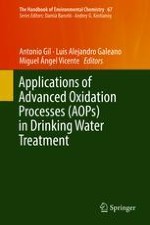2019 | OriginalPaper | Buchkapitel
Disinfection by Chemical Oxidation Methods
verfasst von : Luis-Alejandro Galeano, Milena Guerrero-Flórez, Claudia-Andrea Sánchez, Antonio Gil, Miguel-Ángel Vicente
Erschienen in: Applications of Advanced Oxidation Processes (AOPs) in Drinking Water Treatment
Aktivieren Sie unsere intelligente Suche, um passende Fachinhalte oder Patente zu finden.
Wählen Sie Textabschnitte aus um mit Künstlicher Intelligenz passenden Patente zu finden. powered by
Markieren Sie Textabschnitte, um KI-gestützt weitere passende Inhalte zu finden. powered by
